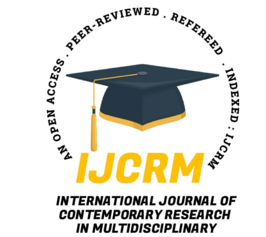International Journal of Contemporary Research In Multidisciplinary, 2023;2(6):44-51
Assessing Agricultural Soil Variability in Mandal Taluka, Ahmedabad, Gujarat: Implications for Crop Suitability and Ecosystem Dynamics
Author Name:
Saif Bakr Hamoodi Hiteshkumar Arvind Solanki
Paper Type: research paper
Article Information
Abstract:
Land degradation poses a significant threat to food security and socioeconomic well-being, exacerbated by various human activities such as construction, dumping, deep plowing, continuous agricultural land use, deforestation, changes in land use, alterations in land topography, deep soil modifications, regulation of soil water, excessive use of nutrition and fertilizers, and heavy reliance on pesticides and insecticides, resulting in nutrient depletion and loss of topsoil. There is an urgent need for a thorough reevaluation of soil conditions to enhance soil quality. This paper presents a study focused on the physicochemical parameters of soil in Mandal Taluka, Gujarat.
Keywords:
Soil Variability, Crop Suitability, Pesticides, Fertilizers, Boron, Gossypium herbaceum
Introduction:
Land degradation is one of the important issues, which have a direct relation with the food security of the world due to its major threats to crop protection. Factors such as Geographical location, climate change, and economic conditions are important factors related to land degradation. An increase in Stalinization, alkalization, and waterlogging are factors that affect land degradation in the Nile Delta region (Mohamed et al., 2019) [8]. Other factors such as a rapid increase in human population, soil erosion, decreasing green cover, and unbalanced crop and livestock production are also important factors in Ethiopia (Taddese et al., 2001)[21]. Heavy use of pesticides and fertilizers (Shaviv and Mikkelse, 1993; Hossain et al., 2022)[19][4], ammonia emission from synthetic fertilizers (Ouyang et al., 2018)[11], overgrazing (Kairis et al., 2015, Niu et al., 2019)[5][10], Stalinization (Modaihsh et al., 2014)[7], land use (Senjobi and Ogunkunle., 2011)[18], desertification (Vogt et al., 2011)[23], Sodicity (Qadir et al., 2006)[16]. India’s western regions especially Rajasthan and Gujarat are considered as semi-arid zone (Patel et al., 2022)[14]. The Mandal region of Ahmedabad district is also belonging to this region. The soil region of Mandal is less fertile due to an excess amount of salt concentration. Soil microflora amount is low due to less water holding capacity and soil structure is unfavorable for bacteria and fungi. This is one of the reasons behind the land degradation in this area (Garg, 1998; Bhawmik et al., 2019)[1][3]. Desertification decreases soil fertility, land does not support life, and crops and domestic animals survive. It influences ecology, the economy, and social life (Pilania et al., 2015; Parmar et al., 2021)[13][15]. In Gujarat, 29.32% of soil was under the degradation of the total geographical area in 2011-2013 by a survey of SAC, 2016. Gujarat has the 4th highest land degradation in India. Many reasons are responsible, such as poor cultivation, inappropriate land management, and drought. The major impact of soil degradation is increasing the input cost and decreasing the output in agricultural practices. Soil erosion is one of the main factors responsible for land degradation (Pilania et al., 2015; SAC, 2016)[15] [20]. The second reason is water erosion, 19.67% land of the TGA is degraded by water erosion. total degraded area in the state is 3,129 thousand hectares. vegetative soil cover is decreased by excessive grazing and reduced agricultural practice (Patel et al., 2022)[14].
How to Cite this Article:
Saif Bakr Hamoodi and Hiteshkumar Arvind Solanki. Assessing Agricultural Soil Variability in Mandal Taluka, Ahmedabad, Gujarat: Implications for Crop Suitability and Ecosystem Dynamics. International Journal of Contemporary Research in Multidisciplinary. 2023: 2(6):44-51
Download PDF





